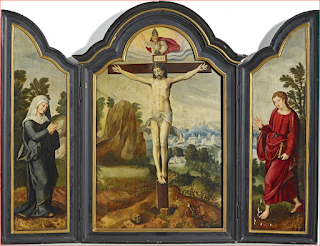Van Ham, from Germany, sells on 19 May 2017 an "Antwerp Master, ca. 1520" crucifixion triptych estimated at 10,000 to 15,000 Euro.
It is a very nice, complete triptych, and what caught my eye were the reverse of the wings. They display an Annunciation in grisaille (or near-grisaille, flesh and hair are coloured but the remainder is black and white). Searching for "Flemish painting grisaille annunciation" gives only a few results, but these are from the very, very best 15th century painters. This of course is selection bias, you have much more chance to find works by the best known artists on the internet than works by lesser gods, but I have rarely seen this effect at work in such an extreme fashion.
The examples above are by Hans Memling (who also colours the flesh and hair), Hugo van der Goes, Gerard David (again coloured), and Van Eyck.
Of course, looking a bit further, e.g. at the RKD, reveals many other examples, some a lot closer to the one for sale, e.g. by Joos van Cleve, the Master of the Ursula Legend, or the Master of Frankfurt.
One of the closest to the one for sale is by Barend van Orley, from the Museums of Fine Arts of Belgium (here from the RKD, the link at the Museum gives a Bad Gateway error...). The central of the triptych here is a deposition: it is usual for these to contrast the annunciation on the outside with the death of Christ in some form on the inside. It is from ca. 1521 (so the same date), and also has the angel Gabriel barefooted and in a similar pose. The painting style of the work for sale is somewhat different though, so while perhaps Orley was an inspiration, he wasn't the author of this work.
Back to the actual work, the triptych of the crucifixion. It has a lot of resemblances to another anonym work which was, according to the RKD, earlier attributed to Van Orley as well. Once is coincidence, twice is something of a pattern. The position of the virgin, christ, and especially Saint John, with his left feet front and outwards facing.
But in the end it will remain an anonymous work, from the circle of Van Orley but not by his studio. It is firmly rooted in the Flemish tradition, and especially the reverse of the wings is very well achieved. A complete triptych of reasonable proportions (probably intended for a smallish church or a castle chapel, not for more private devotion) in good condition is becoming rare on the market, and this is reflected in the estimate, which seems reasonable.
UPDATE: sold for 10,000 Euro.









No comments:
Post a Comment